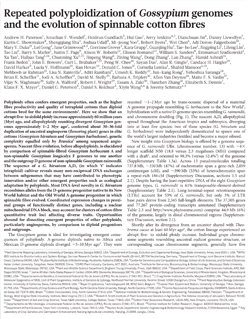News at the HPC²
IGBB Director's Research Published in Nature
December 20, 2012 Dr. Daniel Peterson, Director of the Institute for Genomics, Biocomputing and Biotechnology (IGBB), is part of an international team that has described the first "gold-standard" genome sequence for cotton. The findings were published in the December 20th issue of Nature. The research is the culmination of a 20-plus year effort in the analysis of cotton genes, chromosomes and their evolution.
Dr. Daniel Peterson, Director of the Institute for Genomics, Biocomputing and Biotechnology (IGBB), is part of an international team that has described the first "gold-standard" genome sequence for cotton. The findings were published in the December 20th issue of Nature. The research is the culmination of a 20-plus year effort in the analysis of cotton genes, chromosomes and their evolution.The research consortium includes representatives from most of the world's major cotton producing countries, and is led by Regents Professor Andrew Paterson of the University of Georgia. The effort gained momentum in 2007 when a proposal from Paterson, Peterson and others was approved by the United States Department of Energy Joint Genome Institute Community Sequencing Program. A "gold-standard" sequence was produced for Gossypium raimondii, chosen by the worldwide cotton community to be the first of 50 cotton species to be sequenced as the best model for the New World progenitor of commercially important Upland and Pima cottons.
The IGBB which is part of the High Performance Computing Collaboratory in the Thad Cochran Research, Technology and Economic Deveopment Park at MSU and the USDA-ARS augmented the scope and impact of the research by producing draft sequences of a model for the other Upland and Pima (Old World) progenitor, G. herbaceum, as well as the commercially important Upland cotton (G. hirsutum) cultivar 'Acala Maxxa,' and a wild relative, G. longicalyx.
Dr. Peterson, in partnership with Brian Scheffler of the USDA-ARS at Stoneville, used an existing IGBB/USDA cooperative agreement to conduct targeted DNA sequencing critical in assembly of the G. raimondii genome. Additionally, the IGBB/USDA team sequenced the three Gossypium genomes to which the G. raimondii reference was compared. Other IGBB co-authors on the paper were research associate Kurt Showmaker and postdoctoral associate William S. Sanders, both of whom were involved in DNA sequencing, data management, and identification of sequence differences between species.
To view the full news release, please see: Mississippi State University News. As well as the article in Nature.
